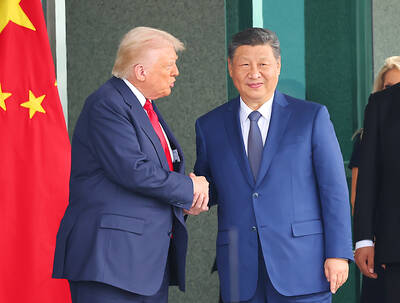Taiwan Power Co (Taipower, 台電) yesterday announced that it is teaming up with Taiwan International Ports Corp (台灣港務) to build the nation’s first offshore wind port in Taichung, as part of the state-run utility’s efforts to help accelerate the nation’s “green” energy development.
The project, in which Taipower is to invest more than NT$3 billion (US$98.52 million), is to be the largest offshore wind port in Southeast Asia, the utility said.
“This project will play a major role in the development of the ‘green’ energy industry in Taiwan,” Vice Minister of Economic Affairs Yang Wei-fuu (楊偉甫) said in Taichung while overseeing the ceremony.
The offshore wind port is to consist of two wharfs and a plot of land at Taichung Port (台中港) with a combined size of 12.8 hectares.
Onshore assembly on the wharfs would reduce the risk and difficulty of assembling the 32m wind turbine pylons and their 32.5m-long blades, the utility said.
As the planned offshore wind farm is only 40km from the Taichung harbor, it would shorten the time it would take ships to deliver the prepared wind turbines, Taipower said.
Taiwan International Ports is to expand the weight capacity of each wharf from 3 tonnes per square meter to 50 tonnes per square meter. It is also to dump 1.5m thick layer of gravel on the seabed to enhance its capacity to handle the weight of the turbines.
Taipower chairman Chu Wen-chen (朱文成) said the company could assemble at least 30 wind turbines per year when the weight capacity expansion plan is completed in 2019, which means a total of 600 wind turbines could be assembled in the next 20 years.
Taipower plans to gradually assemble 360 wind turbines over the next 20 years and lease the wharf to other power companies to assemble their components, Chu said.
The utility has also initiated a program to install a batch of 22 offshore wind turbines with a combined installed capacity of between 108 and 110 megawatts by the end of 2020 off the coast of Changhua County, Chu said.
The 22 wind turbines would generate 360 million kilowatt-hours, enough power for 100,000 households, Chu said, adding that the first of the 22 wind turbines would be assembled in June 2019 at the earliest.
The second phase of the project would be to install 116 offshore wind turbines with a combined installed capacity of 900 megawatts, Chu said, without offering a time frame.

RUN IT BACK: A succesful first project working with hyperscalers to design chips encouraged MediaTek to start a second project, aiming to hit stride in 2028 MediaTek Inc (聯發科), the world’s biggest smartphone chip supplier, yesterday said it is engaging a second hyperscaler to help design artificial intelligence (AI) accelerators used in data centers following a similar project expected to generate revenue streams soon. The first AI accelerator project is to bring in US$1 billion revenue next year and several billion US dollars more in 2027, MediaTek chief executive officer Rick Tsai (蔡力行) told a virtual investor conference yesterday. The second AI accelerator project is expected to contribute to revenue beginning in 2028, Tsai said. MediaTek yesterday raised its revenue forecast for the global AI accelerator used

TEMPORARY TRUCE: China has made concessions to ease rare earth trade controls, among others, while Washington holds fire on a 100% tariff on all Chinese goods China is effectively suspending implementation of additional export controls on rare earth metals and terminating investigations targeting US companies in the semiconductor supply chain, the White House announced. The White House on Saturday issued a fact sheet outlining some details of the trade pact agreed to earlier in the week by US President Donald Trump and Chinese President Xi Jinping (習近平) that aimed to ease tensions between the world’s two largest economies. Under the deal, China is to issue general licenses valid for exports of rare earths, gallium, germanium, antimony and graphite “for the benefit of US end users and their suppliers

Dutch chipmaker Nexperia BV’s China unit yesterday said that it had established sufficient inventories of finished goods and works-in-progress, and that its supply chain remained secure and stable after its parent halted wafer supplies. The Dutch company suspended supplies of wafers to its Chinese assembly plant a week ago, calling it “a direct consequence of the local management’s recent failure to comply with the agreed contractual payment terms,” Reuters reported on Friday last week. Its China unit called Nexperia’s suspension “unilateral” and “extremely irresponsible,” adding that the Dutch parent’s claim about contractual payment was “misleading and highly deceptive,” according to a statement

Artificial intelligence (AI) giant Nvidia Corp’s most advanced chips would be reserved for US companies and kept out of China and other countries, US President Donald Trump said. During an interview that aired on Sunday on CBS’ 60 Minutes program and in comments to reporters aboard Air Force One, Trump said only US customers should have access to the top-end Blackwell chips offered by Nvidia, the world’s most valuable company by market capitalization. “The most advanced, we will not let anybody have them other than the United States,” he told CBS, echoing remarks made earlier to reporters as he returned to Washington